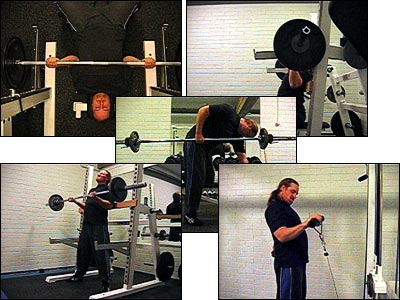December 2004 archives
December 1, 2004
A bit over the top
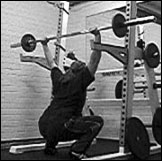 I’m going to swallow my pride and admit that I got no more than 4 @ 62.5 kg/138 lbs on the deep front squats before crashing into the pins. It wasn’t pretty either as my upper body dipped forward quite a bit. Then moved into the good mornings off the pins, now starting them, as Vince suggested, straight off the pins instead of first unracking. Worked up to 5 @ 80 kg/177 lbs, which was still fairly light. Next up were…
I’m going to swallow my pride and admit that I got no more than 4 @ 62.5 kg/138 lbs on the deep front squats before crashing into the pins. It wasn’t pretty either as my upper body dipped forward quite a bit. Then moved into the good mornings off the pins, now starting them, as Vince suggested, straight off the pins instead of first unracking. Worked up to 5 @ 80 kg/177 lbs, which was still fairly light. Next up were…
OVERHEAD SQUATS! Never tried them before, but an article in the December 2004 issue of MILO by Rob Haan titled An Alternate King: Overhead Squats put them on my agenda. Much like the hands-free squats, they smelled like a worthy challenge with some core benefits:
Mike Stone also said that very few athletes can even hold a light bar or stick directly overhead and squat, which I have found to be true. The reason is that as you squat, the torso leans forward, and because the arms must remain straight overhead to prevent the bar from falling forward, the shoulders are placed at an extreme stretch. Thus, the overhead squat is testing hip, lower back, and shoulder flexibility all at the same time, and if you are lacking in any area, the bar will end up on the floor. [..] An additional benefit - and my primary motivation for including overhead squats in a training program is that they are a great builder of core strength. [..] Overhead squats work the abdominals in the same way they are worked when you are supporting or carrying a heavy weight.
Rob Haan: An Alternate King: Overhead Squats. MILO 12(3), December 2004: pp. 56.
I also got some valuable hints from Skinny Bastard:
Always “pull the bar apart”–helps with stability.
Point the elbows out to the sides.
It’s OK to the let the bar go behind your head somewhat. For less flexible lifters, it’s usually required.
The limiting factor in terms of flexibility is usually the hamstrings and shoulders.
Start with a broomstick. Don’t expect to get depth. Just “find your balance” and go as low as possible without rounding your back. Move onto the bar and then use weight.
After all the dire warnings about impossible broomsticks and barbell-shaped heavy falling objects, working up to a successful deep set with miniscule plates felt like a major victory (TODAY’S VIDEO 3.4M). It did stretch my shoulders to the limit and I would not have dared going heavier for this very reason. I could also feel it in my upper back, which was forced into a limit arch. Torture tends to bring back memories and what I got was flashbacks of reading about Wendler’s suggestion for arching the upper back, which “not only set the entire back into a perfect squatting position, but you also force the chest out“… all essential things to staying upright in a squat. Since the overhead squat, unlike the front squat, forces you into an erect squatting groove it would seem that it is a good teacher. Alas, it is soon time to see if Mikesell would still be willing to help me work on my form.
Front squats, deep with medium stance:
5 @ 40 kg/88 lbs
5 @ 50 kg/111 lbs
5 @ 62.5 kg/138 lbs
Good mornings, off pins set at navel height:
5 @ 40 kg/88 lbs
5 @ 50 kg/111 lbs
5 @ 60 kg/133 lbs
5 @ 70 kg/155 lbs
5 @ 80 kg/177 lbs
Overhead squat, deep: worked up to 5 @ 30 kg/66 lbs
Upper body cable turn:
20 @ 40 kg/88 lbs
20 @ 50 kg/111 lbs
Standing cable crunch:
8 @ 30 kg/66 lbs
8 @ 40 kg/88 lbs
2 @ 50 kg/111 lbs
Total training time: Under 60 min
December 2, 2004
December 2004 Reader Survey
 Although I have come to know some of my readers through e-mail and comments, blogging still largely feels like writing small notes that are then sucked into the great unknown. After one-and-a-half years of writing for Under the Bar and just six posts short of 300, I now think it’s high time I torture you, Dear Reader, with a survey.
Although I have come to know some of my readers through e-mail and comments, blogging still largely feels like writing small notes that are then sucked into the great unknown. After one-and-a-half years of writing for Under the Bar and just six posts short of 300, I now think it’s high time I torture you, Dear Reader, with a survey.
More than just a pseudo-scientific attempt at satisfying my own egocentric curiosity, this survey is also an excellent opportunity for you to tell me what could be done better and what should definitively not be abandoned with a few simple mouse clicks.
To show my appreciation, there is of course a lottery involved and you get to choose what you would like to win: A Captains of Crush gripper, a pair of minibands from Jumpstretch, the book The Training of the Weightlifter by Roman or a Westside T-shirt - all brand new of course. I would like to emphasize that the winner will be completely randomly drawn with no regard for how (s)he filled out the survey. So go on and fill it out honestly (no double entries permitted). The survey will be closed on December 12 at 21:00 EET (GMT +2) with results and the lottery winner announced within 10 days after that. If there are more than 30 respondents (fat chance, right?) I pledge to draw two winners.
December 5, 2004
The lift was a splashing success
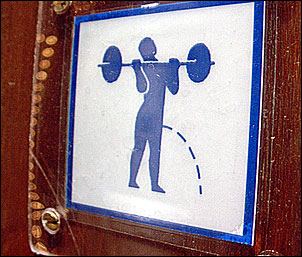
“Allt ska man se innan ögonen trillar av”, my beloved grandfather used to say. “Oh, the things my eyes have to see before they roll off” indeed comes to mind before this toilet sign. (Tom Tits Experiment science centre, Södertälje, Sweden).
December 6, 2004
An isokinetic experience
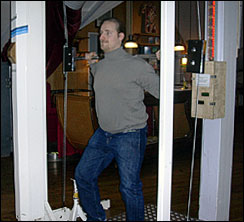
Tom Tits Experiment science centre is famous not only for its vast array of experiments from the fields of physics and chemistry, but also for its pedagogical approach of letting children learn by literary diving into the experiments on display. This was the main reason why a group of teachers, yours truly included, made the journey to the centre situated just outside of Stockholm, Sweden. That being said, powerlifters will also find something of interest here besides lessons in leverage and friendly toilet facilities. That something is the IsoKai isokinetic machine standing in the human body exhibition (take a left after the brains).
Developed in the 1990s by Swede Kai Lindberg, the IsoKai features a wire suspended barbell connected to a hydraulic system that ensures that the barbell always travels at the same speed regardless of how hard it is moved - basically, the machine generates resistance that corresponds precisely with the amount of force applied to keep speed constant. The bar can easily be lifted with two fingers, but press with all your might and you will find yourself lifting as much as you can handle.
This kind of isokinetic resistance theoretically allows the lifter to maximally activate the muscles throughout the range of motion at a particular speed - on a deadlift you might find yourself with 150 kg of resistance off the floor and 200 kg at lockout. Naturally, a conventional barbell will force the muscles to work maximally only at the sticking point.
The history of isokinetic machines goes back to 1967 when the Cybex I dynamometer (pdf file) was launched in the USA, but it was in the mid 1980s that they became popular when they were hooked up to computers for real-time feedback. Incidentally, the birth of the isokinetic machines coincides with Arthur Jones’s attempt to match resistance with maximum force capacity with his shell-shaped Nautilus cam. If it is true that both isokinetic and Nautilus machines do a pretty good job at forcing the muscle to work maximally, why are we still hooked on barbells?
Well, it boils down to three main things (at least):
- they are not functional, since there are few activities where we encounter this kind of resistance - for example, to hoist a heavy barbell we need to overcome gravity and learn to build enough speed to overcome the sticking point.
- they don’t require as much stabilizing as a free weights, thus less muscle mass is triggered - this is why squatting in a Smith machine or IsoKai will never produce the same results as going at it with a barbell.
- they (especially the isokinetic machines) don’t provide enough resistance when lowering the bar (eccentric muscle action) to promote optimum strength development.
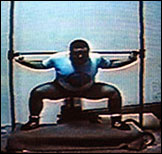 This is not to say that they don’t have their place in powerlifting. On the Westside Barbell Squatting Secrets tape (1993), Simmons credits Fred “Dr. Squat” Hatfield with introducing him to isokinetic training and goes on to explain how the machine is used at Westside with Mark Borda demonstrating (left). The short of it is that a couple of months out of the contest the force meter is set at a slow speed, but as the contest draws nearer the speed is increased while the lifter attempts to keep the force constant - if a lifter can go from reaching 1000 lbs over three seconds to producing the same force in two seconds he has clearly become faster. Not sure if this machine is still used at Westside Barbell Club, but I for one would not object to find one at my gym; the IsoKai price tag of 69,000 SEK/8,000 euros, excluding the PC, makes sure I won’t (the price is likely higher now since the quote is from 1999).
This is not to say that they don’t have their place in powerlifting. On the Westside Barbell Squatting Secrets tape (1993), Simmons credits Fred “Dr. Squat” Hatfield with introducing him to isokinetic training and goes on to explain how the machine is used at Westside with Mark Borda demonstrating (left). The short of it is that a couple of months out of the contest the force meter is set at a slow speed, but as the contest draws nearer the speed is increased while the lifter attempts to keep the force constant - if a lifter can go from reaching 1000 lbs over three seconds to producing the same force in two seconds he has clearly become faster. Not sure if this machine is still used at Westside Barbell Club, but I for one would not object to find one at my gym; the IsoKai price tag of 69,000 SEK/8,000 euros, excluding the PC, makes sure I won’t (the price is likely higher now since the quote is from 1999).
As far as isokinetic machines go, the IsoKai is cool because it gives resistance in both directions - I could first military press a mean resistance of 65 kg/144 lbs followed by a standing pulldown of 80 kg/177 lbs. Of course, the bar could also be lowered more easily when not pulling down on it like a rabid grizzly. FWIW, got a mean force of 135 kg/298 lbs on the deadlift.
The IsoKai is currently widely used to test candidates for the Swedish police and armed forces, which usually means having to pull the bar from below the knees up to the upper chest (this movement shown at Tom Tits). According to this pdf article in Swedish, the IsoKai has replaced three muscle tests previously used in the military (it also claims IsoKai is great for diagnosing whiplash injuries by looking at the force curve plotted by the computer).
Anyone got any experience with isokinetic machines?
Making the rounds
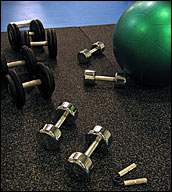 Finnish Independence Day. No work. To give the central nervous system and the shoulders further respite, I went for an upper body circuit routine with fairly light weights, one major movement per muscle group and a focus on stability ball exercises. I moved quickly between exercises only stopping to jot down the results until one iteration was completed, then took five minutes of rest before going at it again. I was huffing and puffing and kept reminding myself of the need to raise GPP, cause I ain’t got any. 23 minutes later it looked like the 5th Annual Dumbell Congregation had just convened in front of the stability ball. On our way home we ended up sitting in a traffic jam as the police had just blocked off one of the main arteries to make room for the dignitaries on their way to the President’s Independence Day Reception. System flooded with healing blood, can wait.
Finnish Independence Day. No work. To give the central nervous system and the shoulders further respite, I went for an upper body circuit routine with fairly light weights, one major movement per muscle group and a focus on stability ball exercises. I moved quickly between exercises only stopping to jot down the results until one iteration was completed, then took five minutes of rest before going at it again. I was huffing and puffing and kept reminding myself of the need to raise GPP, cause I ain’t got any. 23 minutes later it looked like the 5th Annual Dumbell Congregation had just convened in front of the stability ball. On our way home we ended up sitting in a traffic jam as the police had just blocked off one of the main arteries to make room for the dignitaries on their way to the President’s Independence Day Reception. System flooded with healing blood, can wait.
3 circuits of:
Stability ball dumbell bench: 12 @ 21 kg/46 lbs
Wide-grip pulldown, facing away from machine: 10 @ 60 kg/133 lbs
Side raise kneeling on stability ball: 8 @ 10 kg/22 lbs
Dumbell power clean sitting on stability ball: 12 @ 8 kg/18 lbs
Pressdown (lat pulley): 15 @ 25 kg/55 lbs
Dumbell curl seated on stability ball: 6 @ 16 kg/35 lbs
Captains of Crush: 10 @ Trainer
Lap times: 1st 4:40, 2nd 4:10, 3rd 4:10
Rest between circuits: 5 minutes sharp
Total training time: 23 min
December 8, 2004
Lift n’learn
Training blogs seem to be sprouting left and right. Following in Marie’s footsteps, I browsed in at John McDonald’s Lift n’learn started November 30th. He describes himself as a “drug-free, genetically average newbie powerlifter”, who “has not yet competed” and has been focusing on powerlifting since March 2004. He is also a stout defender of unspiced sushi lifting going at it 100% raw and drug-free. Sounds like another blog to frequent… I need to start using those RSS feeds when available pretty soon or I’ll find myself swapping all over the net looking for updates… Not that I am complaining.
Speaking of journals, Mike moved his to the Joe Average board after starting to train with Joe Parrish at Nazareth Barbell. That should make him even stronger… FAST! Note that access to it requires registration.
Poke her with the soft cushions!
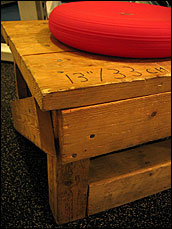 The school received a few Dynair air cushions from TOGU. These can be used for anything from sitting on (great for bad backs) to standing on for balance training. Being SQ/DL day and all, I couldn’t resist the urge to borrow one for box squats. I seem to recall reading about this precise setup somewhere, but some brief surfing turned up squat (punny yes).
The school received a few Dynair air cushions from TOGU. These can be used for anything from sitting on (great for bad backs) to standing on for balance training. Being SQ/DL day and all, I couldn’t resist the urge to borrow one for box squats. I seem to recall reading about this precise setup somewhere, but some brief surfing turned up squat (punny yes).
The idea of squatting off a soft box is not breaking news. On the Squatting Secrets tape, Simmons says that he began using a soft box back in the 1970s. These soft boxes, or hassocks, are nothing more than cheap foot rests that can be found at furniture stores (like these expensive ones, some have found theirs for less than $10 in the States). With a solid bottom and cushy top, squatting off them will make the lifter sink in a couple of inches. Needless to say, this makes the lift a lot harder and hits the legs more than an ordinary hard box. Hassock squats resemble free squats closely and are thus, or were at least, used the last 3-4 weeks prior to a meet at Westside.
Slapped the Dynair on top of my 13″ box and began pyramiding up. The cushion was indeed fairly unstable, but nothing compared to a stability ball… Tried to concentrate on form, especially arching the upper back and pulling shoulder blades tightly together while keeping elbows in. This made for added shoulder strain, but resulted in perhaps a bit less forward dipping (some older footage to compare with). Did around 10 sets at 60 kg/133 lbs then pyramided up. On the 90 kg/199 lbs single, I setup a tad too close with the result that I hit the outer edge of the cushion tilting it backwards. In the process the plates on the left side also slid out several inches. I felt some strain on the inside of the left leg from the unbalanced load and it was a really slow rep but up it came. Moved the box a bit further back for 100 kg/221 lbs, but got into a really sorry position and couldn’t even get lift off. Accessory work in circuit fashion was the coup de grâce.
This was the first semi-serious ME DL/SQ session in many months and no complaints from the back. I plan to reintroduce DE SQ/DL workouts to regain some speed and allow for further technique refinement. I’m momentarily quite content with my bench form, so expect more than a passing note on squat technique in the weeks to come. Meanwhile, feel free to lash harsh critique on today’s action (VIDEO 1M) powered by Slipknot’s Vol.3: The Subliminal Verses.
Soft cushion box squat, 13″:
Worked up to several sets @ 60 kg/133 lbs
1 @ 70 kg/155 lbs
1 @ 80 kg/177 lbs
1 @ 90 kg/199 lbs
0 @ 100 kg/221 lbs
3 circuits:
Pull-through, straight-legged: 15 @ 70 kg/155 lbs
Cable side bend: 10 @ 70 kg/155 lbs
Incline sit-up: (12,11,6)
Shrug: 10 @ 100 kg/221 lbs
Rolling Thunder: (3,2,1) @ 40 kg/88 lbs
Fastest circuit lap time: 3:40 on third iteration
Total training time: 67 min
December 10, 2004
It looks like an innocent board, but…
To save my nose for the benefit of mankind, I got myself a board to use as a backrest on the seated pin press. The Spirit of the Barbell nodded in approval as the bar did no longer need to clear Cape Head before moving into a proper groove. Later on in the workout, the board also came in handy as a back rest to assure good form and zero momentum on barbell curls. This simple board is already turning into one of my most useful gym accessories.
Partially solved the problem of not having heavy enough dumbells to replace the risky bent over rows (my back) by doing one-handed rows with the barbell. The advantage over dumbells is that you can pull very close to your waist as there are no plates to hit the thighs, but you can’t move the supporting leg much out to the side like I usually do since the bar is in the way. Some gentle swaying aside, bar balance is not the huge problem it might first appear to be. Psychologically, the bar also works well since 40 kg/88 lbs on a barbell looks puny whereas a dumbell of the same size is already borderline imposing. Too bad the gym doesn’t have two bars, otherwise I could go back to doing heavy dumbell benching… dumbells are for sissies, right?
VIDEO (5.4MB) (includes Måns demonstrating One-legged lying cable leg extensions in the upper pulley - great exercise for you bodybuilders out there!)
Reverse-grip bench: 4x6 @ 80 kg/177 lbs
Seated pin press, medium grip: 5,4 @ 62.5 kg/138 lbs (going easy with shoulders)
One-handed barbell row: 4x8 @ 40 kg/88 lbs
Standing barbell curl with back support:
4 @ 45 kg/99 lbs
6 @ 40 kg/88 lbs
One-handed reverse cable curl with Rolling Thunder handle: 6,4 @ 18.75 kg/41 lbs
Total training time: 85 min (director’s cut)
A gentle reminder
The reader survey will close on Sunday. The number of respondents isn’t overwhelming, so there is actually a real chance for you to win some powerlifting stuff in the draw. Plus I would appreciate the feedback. And that’s all I’m going to say about that. ![]()
December 11, 2004
New grippers from IronMind
This will probably not be of any real value to fanatic gripsters, but novices struggling with the Captains of Crush Trainer gripper (100 lbs/45 kg of resistance) and those in need of lighter tools for rehab will be pleased to hear that IronMind has just released two lighter versions of their famed gripper. The Guide clocks in at a mere 60 lbs/27 kg of resistance putting it at the level of most sporting goods store grippers, with the Sport providing 80 lbs/36 kg.
There is something in store for those struggling with heavier grippers as well with IronMind also launching Hand Gripper Helpers, which is basically a string that gives 22 lbs/10 kg of extra resistance when grasped together with any gripper thus helping to overcome the fixed weight mentality. As IronMind puts it, “who’d have thought of this: progressive overload for your grippers.” Hmmm… the venerable Ivanko Super Gripper does spring to mind.
December 12, 2004
Survey closed
The reader survey was closed at 21:00 EET (GMT +2). Shortly thereafter, beautiful Lady Fortuna Sanna picked the lucky winner from a casket… a Westside Barbell T-shirt goes out to long-time reader and powerlifter Gareth from the UK. His response to the good news?
AMAZING!!! This is about the first thing I’ve ever won.
The survey result will be made public sometime this week, but at this stage I can reveal that there were 14 respondents. A HUGE THANKS to everyone who responded. If I were rich I’d proclaim you all winners. ![]()
December 13, 2004
Don’t know squat
I trust my back is now stable enough to throttle back to ordinary Westside training. Screams from beyond the grave… DE Squat/Deadlift is back! The need for speed is indeed great, but I hope the near weekly (will follow the three-day rotating Westside split) box squatting sessions can also help rectify my horrendous squat technique. To this effect, I will start out with the Rookie Cycle, intended for this very purpose, out of the Elite Fitness System’s Dynamic Squat manual. Clap your hands, for it goes like this:
ROOKIE CYCLE
Week 1: 35% for 15 sets of 2 reps
Week 2: 40% for 18 sets of 2 reps
Week 3: 45% for 20 sets of 2 reps
Percentages adapted for a raw lifter, deduct 10% if calculated off an equipped max.
Armed myself with print-outs of Dave Tate’s Squatting from Head to Toe and Rob Wagner’s Powerlifting Technique Part I and headed for the gym. First loaded the bar to 90 kg/199 lbs to practice setting up properly. In the past, I’ve just put the bar on my back and then stepped back into my stance in whatever way caught my fancy (you get the picture). Now, I focused on creating a stable base by pulling the bar down hard over the shoulders while pinching the shoulder blades tightly together. Then drove the elbows in under the bar while wishing I had a buffalo bar, unracked and practiced stepping into my stance with two elegant steps. Next time, I think I will try doing it the Mikesell way via three steps as the plates had a tendency to sway out a bit (ok, so I am setting up too far from the rack, admitted). Rack! Repeat for 10 sets or so. Ritual isn’t built in one set.
Next moved into the actual work sets of 15x2 @ 35 kg/77 lbs. Kept the speed purposively a bit slow since the bar can move a little too fast for my well-being when weights are this light. My main concern was to eliminate the usual forward dip on ascent while lessening needless rocking after sitting down on the box… a tall order! I was after as vertically straight a bar path as possible with Wendler’s “picture yourself in a Smith machine” advice ringing in my ears. If the bar is not allowed to deviate from this path, it follows that the sitting back phase is nothing more than arching hard to push the hips and glutes (your colloquial butt) back. To quote Wendler again, “this is a very uncomfortable position and it should be noted that squatting is not a comfortable exercise”. In retrospect, I probably was a bit too comfortable still as I should sit back further still. Mental note to self: shoulder and back discomfort are essential to good squatting technique.
Secondarily, I also did my best to spread the knees to better open up the hips on descent while pushing the feet out sideways (aka “spreading the floor”). Not very intuitive, but we all begin somewhere.
After the 15 light sets, I pyramided up to a couple of sets with 80 kg/177 lbs to see whether I could keep form up with a bit heavier weights. After concluding that this is about where form begins to break down, I moved on to some accessory work before heading home to compare today’s squat footage with other squats filmed from the same angle, i.e. straight from the side. I ended up dissecting Mikesell’s 229 kg/505 lbs raw squat from the Brent’s Hardcore Powerlifting video and Tommy Fannon’s 319 kg/705 lbs box squat with briefs alongside my best rep at 35 kg/77 lbs and the final 80 kg/177 lbs single (VIDEO 1MB). First created a complete breakdown of the lifts with a central axis running from the middle of the foot for comparison purposes (note, this is not necessarily where the bar should be at all times), then used this information to map the bar path for both descent and ascent. The result shows Mikesell and my light set being very close to perfectly straight, while Fannon’s hefty box squats shows a bit of forward dipping although not quite as severe as on my heavier set. When doing this kind of work, layers are your friend whether in Photoshop or The Gimp.
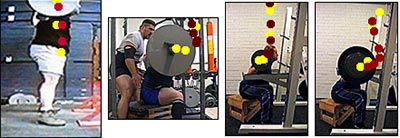
Bar path of Mikesell’s raw squat, Fannon’s box squat and today’s light and heavier box squat. Yellow dots are mapped bar position during descent, red dots bar positions on ascent.
CONCLUSIONS
One thing that strikes me looking at these comparisons is how long my bar path is compared to the other lifters. I am fairly tall at 183 cm/6 feet and could probably gain quite a lot by moving my stance out a bit more. In fact, at Westside a very wide stance is usually used on box work to effectively overload the hip region with the competition stance being more narrow. In my case, widening the stance would probably force me out of the rack, in case of which a spotter would become paramount (ok, perhaps not on DE work). Will experiment.
Secondly, I am quite content with the bar path on my lighter sets, but still think I need to arch harder. The 80 kg/177 lbs set shown on the video was probably a bit better than my usual form when working around 100 kg/221 lbs, but the root of all evil still forces me to take a dip before driving up. What seems to happen is the common mistake of driving off the box too much with the legs instead of driving from the hips, which forces the bar to dip as the head is not driven back early enough. I think I have the same mistake on my light set as well, it’s just that extremely light weights provide good camouflage. Technique wise I need to drive back against the bar more aggressively, strength wise I need to strengthen my lower back at this angle (short range arched back good mornings spring to mind). More work to follow.
Unracking practice, ~10 sets @ 90 kg/199 lbs
Box squat, 13″:
15x2 @ 35 kg/77 lbs
2x2 @ 50 kg/111 lbs
2 @ 60 kg/133 lbs
2 @ 70 kg/155 lbs
2,1 @ 80 kg/177 lbs
Dimel deadlift:
10 @ 50 kg/111 lbs
10 @ 70 kg/155 lbs
10 @ 90 kg/199 lbs
Standing cable crunch:
10 @ 35 kg/77 lbs
10 @ 45 kg/99 lbs
Total training time: less than an hour at least
December 15, 2004
Armless dude breaks bench record!
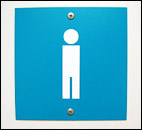 Today was swimming day for the whole school and I spent the day supervising in the swimming stadium (I’m a teacher if you missed that). With no time for lunch, I was feeding on protein-carb shakes all day long. Felt like I was also coming down with something to boot. No surprise then, that I sympathized with the plight of the armless feller who stood guard outside the men’s dressing room - all in line with my recent abnormal interest in signs.
Today was swimming day for the whole school and I spent the day supervising in the swimming stadium (I’m a teacher if you missed that). With no time for lunch, I was feeding on protein-carb shakes all day long. Felt like I was also coming down with something to boot. No surprise then, that I sympathized with the plight of the armless feller who stood guard outside the men’s dressing room - all in line with my recent abnormal interest in signs.
Once I got to the gym I did surprisingly well managing to post a new PR series on the bench although I did have a bit of ass lift-off on the last rep of the first set. So shoot me. I’ve decided to do circuits on ME day for both the bench and the squat/deadlift after the max lift, but feeling like I did I thought it best to not flaunt my luck.
Bench pattern warm-up (the usual)
Heavy bench singles, paused: 1 @ 95 kg/210 lbs
Bench, paused: 6,5,4,3 @ 85 kg/188 lbs
Reverse-grip pulldown to upper chest: 7,5 @ 100 kg/221 lbs
Rope pulls, seated in low pulley: 3x8 @ 50 kg/111 lbs
Standing concentration curl: 8,8,5 @ 13.5 kg/30 lbs (went back and forth)
Rolling Thunder: worked up to a PR attempt of 51.25 kg/113 lbs. Failed.
Rolling Thunder holds: 3 sets @ 40 kg/88 lbs
2″ wooden block pinch grip holds: 2 sets @ 20 kg/44 lbs (no lift on second set with right).
Total training time: Forgot again.
December 17, 2004
Taking it easy with kneeling squats
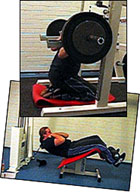 ME SQ/DL. Unaccustomed as my back is to squatting, it felt like a good idea to do something a little less lower back strenuous today. The kneeling squat popped first into my head, probably because I was reminded of its existence while rewatching the Westside Squat Workout tapes earlier in the week. Worked up to a decently heavy 5 reps at 120 kg/265 lbs; it was no max effort, but enough to give the hip flexors some stimulation. My best pre-injury result on the exercise was 10 @ 135 kg/298 lbs.
ME SQ/DL. Unaccustomed as my back is to squatting, it felt like a good idea to do something a little less lower back strenuous today. The kneeling squat popped first into my head, probably because I was reminded of its existence while rewatching the Westside Squat Workout tapes earlier in the week. Worked up to a decently heavy 5 reps at 120 kg/265 lbs; it was no max effort, but enough to give the hip flexors some stimulation. My best pre-injury result on the exercise was 10 @ 135 kg/298 lbs.
Next did incline cable sit-ups with a puny 5 kg/11 lbs of resistance. Got three reps, then continued on with bodyweight reps. I much prefer the cable to holding a plate, because a) cheating is out of the question (the plate can be moved a bit forward to make it easier) and b) the resistance is the same no matter what angle you happen to be in. I’m going to work hard on getting the weights up on this one. Some more ab work, walkouts for core stability and curtains.
Kneeling squat:
10 @ 20 kg/44 lbs
10 @ 30 kg/66 lbs
10 @ 50 kg/111 lbs
5 @ 60 kg/133 lbs
5 @ 70 kg/155 lbs
5 @ 80 kg/177 lbs
5 @ 90 kg/199 lbs
5 @ 100 kg/221 lbs
5 @ 110 kg/243 lbs
5 @ 120 kg/265 lbs
Incline cable sit-up:
3+5, 1+4 @ 5 kg/11 lbs + bodyweight
1+4 @ 5 kg/11 lbs + bodyweight (a bit less incline)
Standing cable crunch: 3x10 @ 40 kg/88 lbs
Walkouts with simultaneous arm and leg lift (opposite): 10, 12
Walkouts with trunk twist: 10
Total training time: Pretty fast.
December 20, 2004
Ejecting
YABAD (Yet Another Blakley Accessory Day). I had trouble keeping my arch throughout the reps on the reverse-grip bench, which has been something of a trend on the normal bench as well. For the third set, I tried applying a liberal amount of chalk on the trap region of my T-shirt and suddenly found myself glued to the bench! Can definitively be recommended for those who have a tendency to flatten out due to slippery T-shirts. Didn’t quite succeed in whizzing past 4x6 @ 82.5 kg/182 lbs after losing the groove on the third set causing the bar to crash into the pins prematurely and coming up one rep short on the fourth set. Then humiliation struck on the seated pin press as I only got 4 @ 62.5 kg/138 lbs - mission aborted after one set.
Some acute elbow strain on the reverse-grip bench and the fact that my seated pin press has really gone nowhere, made me question whether it makes sense to continue doing them as accessories. The last thing I want now is a strained elbow - don’t want one major injury a year if I can avoid it. Some minor ones should suffice.
Come to think of it, it might be time to take a break off the whole Blakley program for a while despite some early signs of renewed progress after overtraining on a modified version of the program (that program is in itself probably great, just couldn’t recuperate from the increased volume). I’ve reached the goal I set when I embarked on it back in August, i.e. I’ve raised my repping weight from 77.5 kg/171 lbs to 85 kg/188 lbs (a 7.5 kg/17 lbs gain), and also broke the 100 kg/221 lbs barrier in the bench. The program put some life back in my stale bench and I’ve got nothing but praise for it, but I could use some variation to keep motivation running high. I might go back to Westside benching for a while to break some of my old records, but am also considering a host of other possibilities including Korte’s 3x3 program a reader raved about, a USSR squat routine adapted for the bench and a simple Mendelson inspired bench single-2 board press routine I got from Mike as a solution to my overtraining problem. Suggestions warmly welcome as usual.
In the meantime, here’s a breakdown, or index if you will, of the Blakley experience. Based on my experience with it, I can highly recommend the program for anyone whose max is stuck/sticky (might even be a good program to cycle back to back with Westside). Blakley will be back, I promise you that!
PROGRESS ON BLAKLEY 4x6 BENCH PROGRAM, 2 AUG-15 DEC 2004
| Workout | Date | Sets | Gain (compared to best at weight) |
| 77.5 kg/171 lbs | |||
| Accessory: Bradford press, JM press | |||
| 1 | 2 Aug | 5,5,4,3 | new |
| 2 | 9 Aug | 5,5,5,4 | +2 |
| 3 | 17 Aug | 6,6,5,5 | +3 |
| 4 | 23 Aug | 6,5,5,5 | -1 |
| Forced to change accessories due to lumbago | |||
| Accessory: Close-grip floor press, triceps extensions | |||
| 5 | 13 Sep | 6,6,6,6 | +2 |
| 80 kg/177 lbs | |||
| 6 | 20 Sep | 6,6,5,5 | new |
| 7 | 27 Sep 2004 | 6,6,6,5 | +1 |
| 8 | 4 Oct | 5 | - |
| 9 | 11 Oct | 6,6,6,6 | +1 |
| 82.5 kg/182 lbs | |||
| 10 | 18 Oct | 4 | new |
| 11 | 25 Oct | 6,6,6,6 | huge gain |
| 85 kg/188 lbs | |||
| Changed to modified program with decline bench. | |||
| Technique change to arch. Posted 102.5 kg/227 lbs PR (up from long-standing 97.5 kg/215 lbs). | |||
| Accessory: Reverse bench, seated pin press | |||
| 12 | 8 Nov | 4,3 | new |
| 13 | 15 Nov | 5,5,3,3 | ~+3 |
| 14 | 22 Nov | 4,4,4,3 | -1 |
| Reverted back to normal program. Took some extra rest to recuperate. | |||
| 15 | 29 Nov | 4,4 | ~-1 |
| 16 | 15 Dec | 6,5,4,3 | +2 |
December 21, 2004
… ahhhh!
After a last hectic crescendo, school is finally over for the year. Long Christmas vacations are a teacher’s privilege, but as anyone who works full-time in an elementary school can attest, we’ve earned every second of it. For the next three weeks this lifter will enjoy good sleep, much increased together time with Sanna, good food… the list goes on and on, but one thing is for sure, this is definitively good news for any possible training progress lurking behind the corner. One deep breath, two deep breaths, three deep breaths… behold the tranquillity that descends upon us!
December 22, 2004
Opening up wide, then sneaking in a PR
Got out of the confines of the narrow rack and widened my stance as planned for the box squats. My first thought when sitting down with the empty bar and feet seemingly a mile apart was “now, how do I get back up?”. Going against gravity turned out to be easy enough so proceeded to several light sets to work on technique especially trying to improve the arch. I still had a tendency to get off the box by pushing off with the legs too much, but at least the quads were on complete vacation as the insides of my legs (adductors) were called in to replace them. Then pyramided up to a bit heavier weights to check technique and get a feeling for the wider stance.
While doing some sets of cable turns I got this crazy idea of going for a new PR on the close-grip floor press since Christmas Eve would make ME Bench a no-go. With only one day of rest separating me from Monday’s bench session, I knew I wasn’t fully recuperated. I figured I would have a reasonable shot at 102.5 kg/227 lbs nonetheless as I believe I am now quite a bit stronger than when I did did 100 kg/221 lbs (later attempt). Got some doubt after being surprised how little force I could produce with 97.5 kg/215 lbs even though the weight felt very light on the descent, but loaded the bar up and went for the PR. It took me a full 10 seconds to complete the rep (no joke, this is timed from the video footage), but I got it up in good form. If my bearings are correct, I should have 105 kg/232 lbs in the bag and a good chance at 107.5 kg/238 lbs when fully rested. We’ll see soon enough.
Besides the obvious stuff, today’s workout clip (2.6MB) also features Måns’s idea of a poor man’s seated calf raise involving the decline bench, a highly intelligent weight loading gadget (me) holding two 21 kg/46 lbs dumbells, and a 40 kg/88 lbs bar for a total resistance of 175 kg/387 lbs… all while having feet on top of two inherently unstable dumbell handles. Quite frankly, the mind boggles over less ingenuity than this.
Box squat, 13″:
10x2 @ 45 kg/99 lbs
worked up to 2 @ 85 kg/188 lbs
Upper body cable turn: 3x20 @ 35 kg/77 lbs
Close-grip floor press: worked up to 102.5 kg/227 lbs PR!
Total training time: about an hour
December 24, 2004
December 27, 2004
Walkout pikes
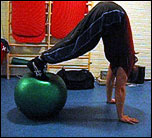 I must have been a good boy this year cause Santa gave me a balance board, tiger balm liniment and Jeck’s stonelifting book off my Amazon.com wishlist in addition to various useful non-strength items. The balance board was especially welcome since I have started to skimp on the rehab stuff after leaving Toffe’s Gym and my homemade board behind. This board is a tad less shaky although being classified as “hard”, but definitively enough for my needs.
I must have been a good boy this year cause Santa gave me a balance board, tiger balm liniment and Jeck’s stonelifting book off my Amazon.com wishlist in addition to various useful non-strength items. The balance board was especially welcome since I have started to skimp on the rehab stuff after leaving Toffe’s Gym and my homemade board behind. This board is a tad less shaky although being classified as “hard”, but definitively enough for my needs.
ME SQ/DL was supposed to be on today’s agenda, but since the venerable lower back has been suffering from some residue stiffness due to the sudden reintroduction of box squats, I dedicated this workout to rehab. First tried a new stability ball exercise known as walkout pikes, essentially a normal walkout followed by folding the body at the midsection (picture) - a great one for the lower abs if you ask me. Then followed up with a rehab circuit with the normal 5 minutes between iterations. Almost lost my lunch after the third one, possibly because I only had it 60 minutes earlier. Lesson learned: the only friendly hamburgers are homemade.
Walkout pike: 10,7,7 @ bodyweight
3 circuits of:
Hanging leg raise (feet to bar): 7,6,5
Balance board lunge: 8,8,8
Hyperextension on stability ball: 15,15,15 @ 10 kg/22 lbs
Lower cable twist: 10, 10, 10 @ 30 kg/66 lbs
Stability ball crunch: 30,30 (skipped last due to aforementioned lunch problems)
Total training time: 40 min
December 28, 2004
New Westside hybrid routine
Got the Elite Fitness Systems’s Training Templates manual yesterday, which inspired me to abandon the traditional ME/DE format in favor for a single day approach combined with an accessory day. Suffice it to say, that this routine is motivated by a desire not to whack my back by doing too much too soon and a desire to experiment with benching once a week only to save the shoulders. The routine is not quite hammered into stone yet, so if anyone has any bright ideas let them shine.
December 29, 2004
15 kg bench PR embalmed
 First workout following my new hybrid routine and what a workout at that! Wide-grip two board benches was a suitably meek target with a modest 95 kg/210 lbs PR back from early 2004 aka the My Bench is Stuck period. Historically, excuse the grand word, my two board has always hovered around the same weights as the regular bench probably because both go below my sticking point. With a 102.5 kg/227 lbs bench and floor press in my pocket, I figured 105 kg/232 lbs would be a sure thing with 107.5 kg/238 lbs being possible. Realistically speaking.
First workout following my new hybrid routine and what a workout at that! Wide-grip two board benches was a suitably meek target with a modest 95 kg/210 lbs PR back from early 2004 aka the My Bench is Stuck period. Historically, excuse the grand word, my two board has always hovered around the same weights as the regular bench probably because both go below my sticking point. With a 102.5 kg/227 lbs bench and floor press in my pocket, I figured 105 kg/232 lbs would be a sure thing with 107.5 kg/238 lbs being possible. Realistically speaking.
Sweeped right up to a 100 kg/221 lbs PR with expected ease. Bagged 105 kg/232 lbs convincingly enough to go directly to 110 kg/243 lbs. The bar got a promising start after having sunk it into the nailed together 2x4 boards, but it ended up stalling… stalling… stalling… resorted to ass lift off and got it up. Dropped down to 107.5 kg/238 lbs and snapped it right up, which really made me wonder how I did not clear 110 kg/243 lbs. Sure enough, on this second attempt it came up beautifully enough to give me hopes for 112.5 kg/249 lbs. Got the descent (haha), but noticed that I had somehow forgot to tuck the elbows… made a desperate attempt to bring them in and pressed… to no avail. Reattempted the weight a few minutes later with proper elbow tucking, but had no strength left. Do I complain? Heck no!
At this point I was really fried. A 70 kg/155 lbs triple was all I had left in store for the incline bench, my chosen low-end exercise for the day, despite the weight itself feeling ridiculously light. Some JMs and lats. The grandfather of all pumps descended. The video (4MB) breaks new ground in the genre of narrative powerlifting clips…
A good stretch and a dull vanilla whey protein-maltodextrin shake later, I rubbed my shoulders and chest with the Tiger Balm muscle rub I got for Christmas from Sanna’s brother and fiancée who recently returned from a diving vacation in Thailand. My thoughts invariably wandered to Sunday’s tragic earthquake in the region and all those residents and tourists who were not so lucky to be somewhere else when the largest quake in 40 years struck… the latest from BBC has the number of dead as high as 100,000. I’m not going to get started on how happiness and sadness is a yin-yang thing, but you get the point. Next week I will hopefully have recovered enough to do a close-grip bench scheme involving weight releasers.
Wide-grip two board press:
worked up to 100 kg/221 lbs over 7 sets
1 @ 105 kg/232 lbs
1 @ 110 kg/243 lbs (ass off bench)
1 @ 107.5 kg/238 lbs
1 @ 110 kg/243 lbs
2x0 @ 112.5 kg/249 lbs
Incline bench:
worked up to 3 @ 70 kg/155 lbs over 5 sets
JM press: 3x12 @ 40 kg/88 lbs
Close-grip pulldown: 4x12 @ 85 kg/188 lbs
Total training time: 67 min
December 30, 2004
Ta-da-dam! The survey results!
The results of the reader survey are long overdue (sorry), but finally found the time to sit down and format them. At the risk of sounding overly emotional, what warms my heart the most is that the vast majority of respondents would be willing to share a training session with me. Before you know it, you might find a long haired Finn waiting for you at the gym ready to max out… Anyway, thanks to all of those who participated.
December 31, 2004
Formula 23
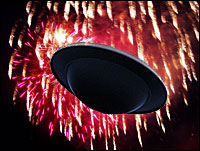 First accessory day of the new routine. Worked fairly quickly, but since the circuits ended up taking close to 30 minutes (5+ minutes per circuit for three and 5 minutes rest in between) only 10 minutes remained for some quick Rolling Thunder work. Not that my grip needed more as 45 kg/99 lbs didn’t even leave the floor today. Unheard of, unheard of… must be the result of Wednesday’s hefty bench session that also left me with overwhelming triceps soreness. Did 100 reps of triceps extensions, 50 reps of Tate presses and 70 reps of dumbell presses yesterday (all on the ball with 2 kg/4 lbs bells), which seemed to help dissipate a bit of the soreness. Hey, I can now almost straighten my arms again!!!
First accessory day of the new routine. Worked fairly quickly, but since the circuits ended up taking close to 30 minutes (5+ minutes per circuit for three and 5 minutes rest in between) only 10 minutes remained for some quick Rolling Thunder work. Not that my grip needed more as 45 kg/99 lbs didn’t even leave the floor today. Unheard of, unheard of… must be the result of Wednesday’s hefty bench session that also left me with overwhelming triceps soreness. Did 100 reps of triceps extensions, 50 reps of Tate presses and 70 reps of dumbell presses yesterday (all on the ball with 2 kg/4 lbs bells), which seemed to help dissipate a bit of the soreness. Hey, I can now almost straighten my arms again!!!
Have a joyous New Year’s Eve everyone! And remember, if you see any UFOs against the fireworks illuminated sky, they are probably just friendly balance boards off into orbit.
Rope pulls in lat pulley: 3x8 @ 45 kg/99 lbs
Standing barbell curl with back support: 4x6 @ 40 kg/88 lbs
3 circuits of:
Walkout pike: 12,12,12
Squat on balance board: 8,8,8
Straight-legged pull-through: 10,10,10 @ 70 kg/155 lbs
Incline sit-up: 10,10,9
Upper body cable turn: 20,20,20 @ 45 kg/99 lbs
Rolling Thunder: worked up to 5 @ 35 kg/77 lbs, failed at 45 kg/99 lbs
Total training time: 60 minutes sharp ![]()
Circuit 1: 5:50 min, circuit 2: 5:20 min, circuit 3: 5:10 min
